Visualizing model training in Fastai/Pytorch
- Some Import & Generic Code
- Create dataset and model
- Define call back, recorder, AvgStatsCallback
- Well lets add Cuda support
- We will visualize std & mean at first few layers
- We initialize model with kaiming normal initialization
- Generalized ReLU
- Based on
One of the challenges in model training is to be sure if our model is initialized correctly.
We also want to debug/visualize the state of model. It helps in model training if we know what we are looking for.
For e.g. if we know the model activations initial value should be normally distributed then, we should make sure we they are normally distributed.
In this post we look for the various methods to visualize model. Post goes through, plotting model state, creating hooks, plotting charts etc.
# only on google colab
!curl -s https://course.fast.ai/setup/colab | bash
Updating fastai...
Done.
%load_ext autoreload
%autoreload 2
%matplotlib inline
import fastai
import torch
fastai.__version__, torch.__version__
('1.0.52', '1.1.0')
Some Import & Generic Code
from fastai.imports import *
import operator
def test(a,b,cmp,cname=None):
if cname is None: cname=cmp.__name__
assert cmp(a,b),f"{cname}:\n{a}\n{b}"
def test_eq(a,b): test(a,b,operator.eq,'==')
from pathlib import Path
from IPython.core.debugger import set_trace
from fastai import datasets
import pickle, gzip, math, torch, matplotlib as mpl
import matplotlib.pyplot as plt
from torch import tensor
MNIST_URL='http://deeplearning.net/data/mnist/mnist.pkl'
def near(a,b): return torch.allclose(a, b, rtol=1e-3, atol=1e-5)
def test_near(a,b): test(a,b,near)
def get_data():
path = datasets.download_data(MNIST_URL, ext='.gz')
with gzip.open(path, 'rb') as f:
((x_train, y_train), (x_valid, y_valid), _) = pickle.load(f, encoding='latin-1')
return map(tensor, (x_train, y_train, x_valid, y_valid))
def normalize(x, mean, std_dev):
return (x-mean)/std_dev
def normalize_to(train, valid):
m, s = train.mean(), train.std()
return normalize(train, m, s), normalize(valid, m, s)
class Dataset():
def __init__(self, x, y):
self.x, self.y = x, y
def __len__(self):
return len(self.x)
def __getitem__(self, i):
return self.x[i], self.y[i]
class DataBunch():
def __init__(self, train_dl, valid_dl, c=None):
self.train_dl,self.valid_dl,self.c = train_dl,valid_dl,c
@property
def train_ds(self): return self.train_dl.dataset
@property
def valid_ds(self): return self.valid_dl.dataset
def get_dls(train_ds, valid_ds, bs, **kwargs):
return (
DataLoader(train_ds, batch_size=bs, shuffle=True, **kwargs),
DataLoader(valid_ds, batch_size=bs*2, **kwargs)
)
Create dataset and model
torch.set_num_threads(2)
x_train,y_train,x_valid,y_valid = get_data()
x_train, x_valid = normalize_to(x_train, x_valid)
train_ds = Dataset(x_train, y_train)
valid_ds = Dataset(x_valid, y_valid)
x_train.mean(), x_train.std()
(tensor(3.0614e-05), tensor(1.))
nh, bs = 50, 512 # hidden , batch size
c = y_train.max().item() + 1
loss_func = F.cross_entropy
data = DataBunch(*get_dls(train_ds, valid_ds, bs),c )
class Lambda(nn.Module):
def __init__(self, func):
super().__init__()
self.func = func
def forward(self, x):
return self.func(x)
def flatten(x):
return x.view(x.shape[0], -1)
def mnist_resize(x):
return x.view(-1, 1, 28, 28)
def get_cnn_model(data):
# import pdb; pdb.set_trace()
return nn.Sequential(
Lambda(mnist_resize),
nn.Conv2d(1, 8, 5, padding=2, stride=2), nn.ReLU(), #14
nn.Conv2d(8, 16, 3, padding=1, stride=2), nn.ReLU(), #7
nn.Conv2d(16, 32, 3, padding=1, stride=2), nn.ReLU(), #4
nn.Conv2d(32, 32, 3, padding=1, stride=2), nn.ReLU(), #2
nn.AdaptiveAvgPool2d(1),
Lambda(flatten),
nn.Linear(32, data.c)
)
model = get_cnn_model(data)
Define call back, recorder, AvgStatsCallback
import re
from typing import *
_camel_re1 = re.compile('(.)([A-Z][a-z]+)')
_camel_re2 = re.compile('([a-z0-9])([A-Z])')
def camel2snake(name):
s1 = re.sub(_camel_re1, r'\1_\2', name)
return re.sub(_camel_re2, r'\1_\2', s1).lower()
class Callback():
_order=0
def set_runner(self, run): self.run=run
def __getattr__(self, k): return getattr(self.run, k)
@property
def name(self):
name = re.sub(r'Callback$', '', self.__class__.__name__)
return camel2snake(name or 'callback')
class Recorder(Callback):
def begin_fit(self):
self.lrs = [[] for _ in self.opt.param_groups]
self.losses = []
def after_batch(self):
if not self.in_train: return
for pg,lr in zip(self.opt.param_groups,self.lrs): lr.append(pg['lr'])
self.losses.append(self.loss.detach().cpu())
def plot_lr (self, pgid=-1): plt.plot(self.lrs[pgid])
def plot_loss(self, skip_last=0): plt.plot(self.losses[:len(self.losses)-skip_last])
class AvgStats():
def __init__(self, metrics, in_train): self.metrics,self.in_train = listify(metrics),in_train
def reset(self):
self.tot_loss,self.count = 0.,0
self.tot_mets = [0.] * len(self.metrics)
@property
def all_stats(self): return [self.tot_loss.item()] + self.tot_mets
@property
def avg_stats(self): return [o/self.count for o in self.all_stats]
def __repr__(self):
if not self.count: return ""
return f"{'train' if self.in_train else 'valid'}: {self.avg_stats}"
def accumulate(self, run):
bn = run.xb.shape[0]
self.tot_loss += run.loss * bn
self.count += bn
for i,m in enumerate(self.metrics):
self.tot_mets[i] += m(run.pred, run.yb) * bn
class AvgStatsCallback(Callback):
def __init__(self, metrics):
self.train_stats,self.valid_stats = AvgStats(metrics,True),AvgStats(metrics,False)
def begin_epoch(self):
self.train_stats.reset()
self.valid_stats.reset()
def after_loss(self):
stats = self.train_stats if self.in_train else self.valid_stats
with torch.no_grad(): stats.accumulate(self.run)
def after_epoch(self):
print(self.train_stats)
print(self.valid_stats)
def accuracy(out, yb):
return (torch.argmax(out, dim=1)==yb).float().mean()
class Learner():
def __init__(self, model, opt, loss_func, data):
self.model,self.opt,self.loss_func,self.data = model,opt,loss_func,data
class TrainEvalCallback(Callback):
def begin_fit(self):
self.run.n_epochs=0.
self.run.n_iter=0
def after_batch(self):
if not self.in_train: return
self.run.n_epochs += 1./self.iters
self.run.n_iter += 1
def begin_epoch(self):
self.run.n_epochs=self.epoch
self.model.train()
self.run.in_train=True
def begin_validate(self):
self.model.eval()
self.run.in_train=False
def listify(o):
if o is None: return []
if isinstance(o, list): return o
if isinstance(o, str): return [o]
if isinstance(o, Iterable): return list(o)
return [o]
class Runner():
def __init__(self, cbs=None, cb_funcs=None):
cbs = listify(cbs)
for cbf in listify(cb_funcs):
# import pdb; pdb.set_trace()
cb = cbf()
setattr(self, cb.name, cb)
cbs.append(cb)
self.stop,self.cbs = False,[TrainEvalCallback()]+cbs
@property
def opt(self): return self.learn.opt
@property
def model(self): return self.learn.model
@property
def loss_func(self): return self.learn.loss_func
@property
def data(self): return self.learn.data
def one_batch(self, xb, yb):
self.xb,self.yb = xb,yb
if self('begin_batch'): return
self.pred = self.model(self.xb)
if self('after_pred'): return
self.loss = self.loss_func(self.pred, self.yb)
if self('after_loss') or not self.in_train: return
self.loss.backward()
if self('after_backward'): return
self.opt.step()
if self('after_step'): return
self.opt.zero_grad()
def all_batches(self, dl):
self.iters = len(dl)
for xb,yb in dl:
if self.stop: break
self.one_batch(xb, yb)
self('after_batch')
self.stop=False
def fit(self, epochs, learn):
self.epochs,self.learn,self.loss = epochs,learn,tensor(0.)
try:
for cb in self.cbs: cb.set_runner(self)
if self('begin_fit'): return
for epoch in range(epochs):
self.epoch = epoch
if not self('begin_epoch'): self.all_batches(self.data.train_dl)
with torch.no_grad():
if not self('begin_validate'): self.all_batches(self.data.valid_dl)
if self('after_epoch'): break
finally:
self('after_fit')
self.learn = None
def __call__(self, cb_name):
for cb in sorted(self.cbs, key=lambda x: x._order):
f = getattr(cb, cb_name, None)
if f and f(): return True
return False
cbfs = [Recorder, partial(AvgStatsCallback,accuracy)]
opt = optim.SGD(model.parameters(), lr=0.4)
learn = Learner(model, opt, loss_func, data)
run = Runner(cb_funcs=cbfs)
%time run.fit(1, learn)
train: [1.69343625, tensor(0.4119)]
valid: [0.53607822265625, tensor(0.8233)]
CPU times: user 6.02 s, sys: 284 ms, total: 6.3 s
Wall time: 3.87 s
Well lets add Cuda support
device = torch.device('cuda',0)
torch.cuda.set_device(device)
class CudaCallback(Callback):
def begin_fit(self):
self.model.cuda()
def begin_batch(self):
self.run.xb,self.run.yb = self.xb.cuda(),self.yb.cuda()
class BatchTransformXCallback(Callback):
_order=2
def __init__(self, tfm): self.tfm = tfm
def begin_batch(self): self.run.xb = self.tfm(self.xb)
def view_tfm(*size):
def _inner(x): return x.view(*((-1,)+size))
return _inner
cbfs.append(CudaCallback)
mnist_view = view_tfm(1,28,28)
cbfs.append(partial(BatchTransformXCallback, mnist_view))
model = get_cnn_model(data)
opt = optim.SGD(model.parameters(), lr=0.4)
learn = Learner(model, opt, loss_func, data)
run = Runner(cb_funcs=cbfs)
%time run.fit(3, learn)
train: [2.1859015625, tensor(0.2155, device='cuda:0')]
valid: [1.4229423828125, tensor(0.5881, device='cuda:0')]
train: [0.6422330078125, tensor(0.7969, device='cuda:0')]
valid: [0.322864404296875, tensor(0.9095, device='cuda:0')]
train: [0.2130225390625, tensor(0.9353, device='cuda:0')]
valid: [0.17388939208984375, tensor(0.9460, device='cuda:0')]
CPU times: user 4.99 s, sys: 1.88 s, total: 6.87 s
Wall time: 6.89 s
We will visualize std & mean at first few layers
class SequentialModel(nn.Module):
def __init__(self, *layers):
super().__init__()
self.layers = nn.ModuleList(layers)
self.act_means = [[] for _ in layers]
self.act_stds = [[] for _ in layers]
def __call__(self, x):
for i,l in enumerate(self.layers):
x = l(x)
if self.training:
self.act_means[i].append(x.data.mean())
self.act_stds [i].append(x.data.std ())
return x
def __iter__(self): return iter(self.layers)
def get_cnn_model(data):
# import pdb; pdb.set_trace()
return [Lambda(mnist_resize)
]+[ nn.Sequential( nn.Conv2d(1, 8, 5, padding=2, stride=2), nn.ReLU())
]+[ nn.Sequential( nn.Conv2d(8, 16, 3, padding=2, stride=2), nn.ReLU())
]+[ nn.Sequential( nn.Conv2d(16, 32, 3, padding=2, stride=2), nn.ReLU())
]+[ nn.Sequential( nn.Conv2d(32, 32, 3, padding=2, stride=2), nn.ReLU())
]+[nn.AdaptiveAvgPool2d(1), Lambda(flatten), nn.Linear(32, data.c)]
model = SequentialModel(*get_cnn_model(data))
opt = optim.SGD(model.parameters(), lr=0.9)
learn = Learner(model, opt, loss_func, data)
run = Runner(cb_funcs=cbfs)
%time run.fit(3, learn)
train: [2.2083478125, tensor(0.1948, device='cuda:0')]
valid: [2.207411328125, tensor(0.3216, device='cuda:0')]
train: [0.745891875, tensor(0.7616, device='cuda:0')]
valid: [0.238783251953125, tensor(0.9278, device='cuda:0')]
train: [0.2101589453125, tensor(0.9362, device='cuda:0')]
valid: [0.13587237548828124, tensor(0.9605, device='cuda:0')]
CPU times: user 2.5 s, sys: 283 ms, total: 2.79 s
Wall time: 2.8 s
Change in mean of first 6 layer for 300 iterations
for l in model.act_means:
plt.plot(l)
plt.legend(range(6));
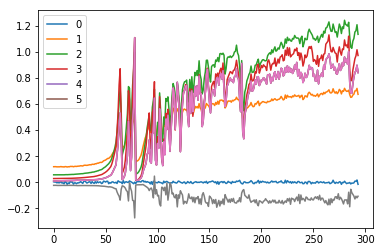
Changes in std of first 6 layers for 300 iterations
for l in model.act_stds:
plt.plot(l)
plt.legend(range(6));

Changes in mean of first 6 layers for 10 iterations
for l in model.act_means: plt.plot(l[:10])
plt.legend(range(6));

Changes in std of first 6 layers for 10 iterations
for l in model.act_stds: plt.plot(l[:10])
plt.legend(range(6));
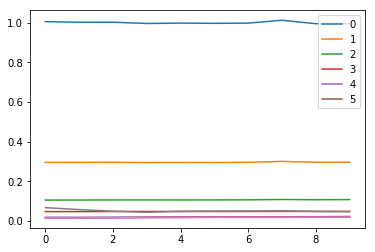
class ListContainer():
def __init__(self, items): self.items = listify(items)
def __getitem__(self, idx):
try: return self.items[idx]
except TypeError:
if isinstance(idx[0],bool):
assert len(idx)==len(self) # bool mask
return [o for m,o in zip(idx,self.items) if m]
return [self.items[i] for i in idx]
def __len__(self): return len(self.items)
def __iter__(self): return iter(self.items)
def __setitem__(self, i, o): self.items[i] = o
def __delitem__(self, i): del(self.items[i])
def __repr__(self):
res = f'{self.__class__.__name__} ({len(self)} items)\n{self.items[:10]}'
if len(self)>10: res = res[:-1]+ '...]'
return res
from torch.nn import init
def children(m): return list(m.children())
class Hook():
def __init__(self, m, f): self.hook = m.register_forward_hook(partial(f, self))
def remove(self): self.hook.remove()
def __del__(self): self.remove()
class Hooks(ListContainer):
def __init__(self, ms, f): super().__init__([Hook(m, f) for m in ms])
def __enter__(self, *args): return self
def __exit__ (self, *args): self.remove()
def __del__(self): self.remove()
def __delitem__(self, i):
self[i].remove()
super().__delitem__(i)
def remove(self):
for h in self: h.remove()
def append_stats(hook, mod, inp, outp):
if not hasattr(hook,'stats'): hook.stats = ([],[])
means,stds = hook.stats
if mod.training:
means.append(outp.data.mean())
stds .append(outp.data.std())
model = nn.Sequential(*get_cnn_model(data)).cuda()
hooks = Hooks(model, append_stats)
hooks
Hooks (8 items)
[<__main__.Hook object at 0x7f62f17be978>, <__main__.Hook object at 0x7f62f17be8d0>, <__main__.Hook object at 0x7f62f17be860>, <__main__.Hook object at 0x7f62f17be128>, <__main__.Hook object at 0x7f62f17bea90>, <__main__.Hook object at 0x7f62f17beb38>, <__main__.Hook object at 0x7f62f17beb00>, <__main__.Hook object at 0x7f62f17bea58>]
opt = optim.SGD(model.parameters(), lr=0.9)
learn = Learner(model, opt, loss_func, data)
run = Runner(cb_funcs=cbfs)
%time run.fit(1, learn)
train: [2.29618875, tensor(0.1267, device='cuda:0')]
valid: [2.2949009765625, tensor(0.1064, device='cuda:0')]
CPU times: user 953 ms, sys: 150 ms, total: 1.1 s
Wall time: 1.11 s
for h in hooks:
plt.plot(h.stats[0])
h.remove()
plt.legend(range(6));
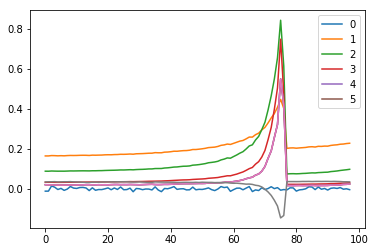
#
with Hooks(model, append_stats) as hooks:
run.fit(2, learn)
fig,(ax0,ax1) = plt.subplots(1,2, figsize=(10,4))
plt.suptitle('Mean & Std for first 10 iter')
for h in hooks:
ms,ss = h.stats
ax0.plot(ms[:10])
ax1.plot(ss[:10])
ax0.title.set_text('Mean is closer to 0')
ax1.title.set_text('Std is closer to 0 instead of 1')
fig,(ax0,ax1) = plt.subplots(1,2, figsize=(10,4))
plt.suptitle('Mean & Std for first all iter')
for h in hooks:
ms,ss = h.stats
ax0.plot(ms)
ax1.plot(ss)
train: [1.890308125, tensor(0.3481, device='cuda:0')]
valid: [0.618567626953125, tensor(0.8094, device='cuda:0')]
train: [0.393958984375, tensor(0.8755, device='cuda:0')]
valid: [0.2235537841796875, tensor(0.9314, device='cuda:0')]
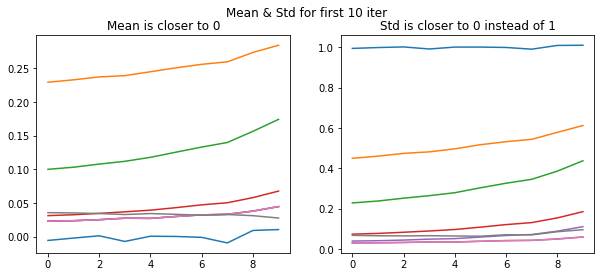
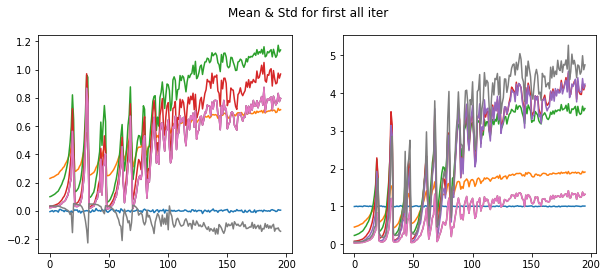
We initialize model with kaiming normal initialization
for l in model:
if isinstance(l, nn.Sequential):
init.kaiming_normal_(l[0].weight)
l[0].bias.data.zero_()
learn = Learner(model, opt, loss_func, data)
with Hooks(model, append_stats) as hooks:
run.fit(2, learn)
fig,(ax0,ax1) = plt.subplots(1,2, figsize=(10,4))
plt.suptitle('Mean & Std for first 10 iter, After Kaiming init')
for h in hooks:
ms,ss = h.stats
ax0.plot(ms[:10])
ax1.plot(ss[:10])
ax0.title.set_text('Mean is closer to 0')
ax1.title.set_text('Std is closer to 0')
fig,(ax0,ax1) = plt.subplots(1,2, figsize=(10,4))
plt.suptitle('Mean & Std for first all iter, After Kaiming init')
for h in hooks:
ms,ss = h.stats
ax0.plot(ms)
ax1.plot(ss)
train: [0.89291625, tensor(0.7141, device='cuda:0')]
valid: [0.222018017578125, tensor(0.9326, device='cuda:0')]
train: [0.215878359375, tensor(0.9342, device='cuda:0')]
valid: [0.15542938232421874, tensor(0.9542, device='cuda:0')]
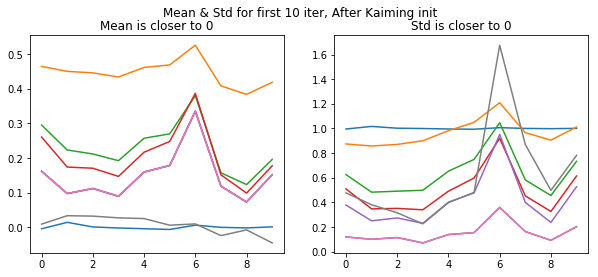
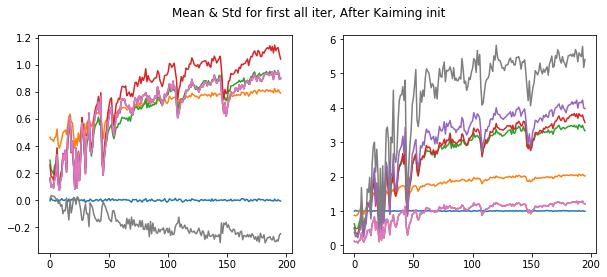
Now it shows our values are starting close to zero mean & 1 std at the start of training
def append_stats(hook, mod, inp, outp):
if not hasattr(hook, 'stats'):
hook.stats = ([], [], [])
means, stds, hists = hook.stats
if mod.training:
means.append(outp.data.mean().cpu())
stds.append(outp.data.std().cpu())
# 40 bins bet 0 & 10
hists.append(outp.data.cpu().histc(40,0,10)) #histc isn't implemented on the GPU
model = nn.Sequential(*get_cnn_model(data)).cuda()
opt = optim.SGD(model.parameters(), lr=0.9)
learn = Learner(model, opt, loss_func, data)
run = Runner(cb_funcs=cbfs)
for l in model:
if isinstance(l, nn.Sequential):
init.kaiming_normal_(l[0].weight)
l[0].bias.data.zero_()
with Hooks(model, append_stats) as hooks:
run.fit(1, learn)
train: [1.5789346875, tensor(0.4872, device='cuda:0')]
valid: [0.741936474609375, tensor(0.7719, device='cuda:0')]
def get_hist(h):
return torch.stack(h.stats[2]).t().float().log1p()
fig, axes = plt.subplots(2,2, figsize=(15,6))
for ax, h in zip(axes.flatten(), hooks[:4]):
ax.imshow(get_hist(h), origin='lower')
ax.axis('off')
plt.tight_layout()
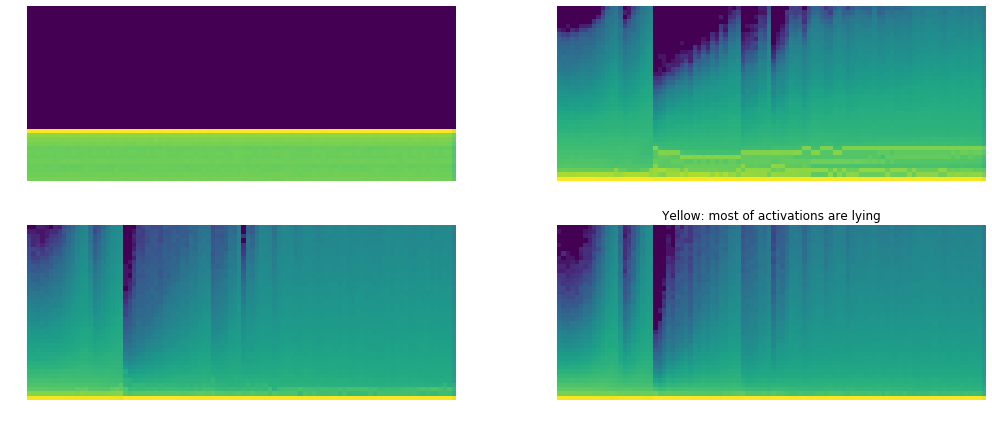
- Yellow : shows most concentration of value.
- Green : little less
- blue/black: no value.
torch.Tensor.ndim = property(lambda x: len(x.shape))
def get_min(h):
h1 = torch.stack(h.stats[2]).t().float()
return h1[19:22].sum(0)/h1.sum(0)
fig,axes = plt.subplots(2,2, figsize=(15,6))
for ax,h in zip(axes.flatten(), hooks[:4]):
ax.plot(get_min(h))
ax.set_ylim(0,.1)
plt.tight_layout()

Most of them are filled with non zero values. But it is not giving mean 0 & std 1
Generalized ReLU
def get_cnn_layers(data, nfs, layer, **kwargs):
nfs = [1] + nfs
return [layer(nfs[i], nfs[i+1], 5 if i==0 else 3, **kwargs)
for i in range(len(nfs)-1)] + [
nn.AdaptiveAvgPool2d(1), Lambda(flatten), nn.Linear(nfs[-1], data.c)]
def conv_layer(ni, nf, ks=3, stride=2, **kwargs):
return nn.Sequential(
nn.Conv2d(ni, nf, ks, padding=ks//2, stride=stride), GeneralRelu(**kwargs))
class GeneralRelu(nn.Module):
def __init__(self, leak=None, sub=None, maxv=None):
super().__init__()
self.leak,self.sub,self.maxv = leak,sub,maxv
def forward(self, x):
x = F.leaky_relu(x,self.leak) if self.leak is not None else F.relu(x)
if self.sub is not None: x.sub_(self.sub)
if self.maxv is not None: x.clamp_max_(self.maxv)
return x
def init_cnn(m, uniform=False):
f = init.kaiming_uniform_ if uniform else init.kaiming_normal_
for l in m:
if isinstance(l, nn.Sequential):
f(l[0].weight, a=0.1)
l[0].bias.data.zero_()
def append_stats(hook, mod, inp, outp):
if not hasattr(hook,'stats'): hook.stats = ([],[],[])
means,stds,hists = hook.stats
if mod.training:
means.append(outp.data.mean().cpu())
stds .append(outp.data.std().cpu())
hists.append(outp.data.cpu().histc(40,-7,7))
def get_cnn_model(data, nfs, layer, **kwargs):
return nn.Sequential(*get_cnn_layers(data, nfs, layer, **kwargs))
nfs = [8,16,32,32]
model = get_cnn_model(data, nfs, conv_layer, leak=0.1, sub=0.4, maxv=6.)
init_cnn(model)
opt = optim.SGD(model.parameters(), lr=0.9)
learn = Learner(model, opt, loss_func, data)
run = Runner(cb_funcs=cbfs)
with Hooks(model, append_stats) as hooks:
run.fit(1, learn)
fig,(ax0,ax1) = plt.subplots(1,2, figsize=(10,4))
for h in hooks:
ms,ss,hi = h.stats
ax0.plot(ms[:10])
ax1.plot(ss[:10])
plt.legend(range(5));
fig,(ax0,ax1) = plt.subplots(1,2, figsize=(10,4))
for h in hooks:
ms,ss,hi = h.stats
ax0.plot(ms)
ax1.plot(ss)
plt.legend(range(5));
train: [0.5154879296875, tensor(0.8358, device='cuda:0')]
valid: [0.15991282958984376, tensor(0.9516, device='cuda:0')]
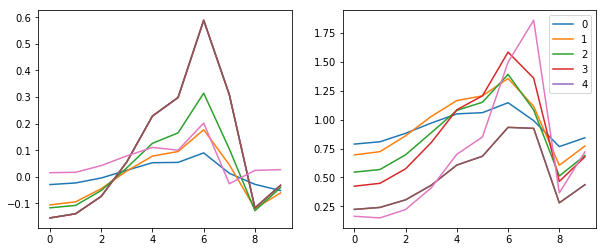
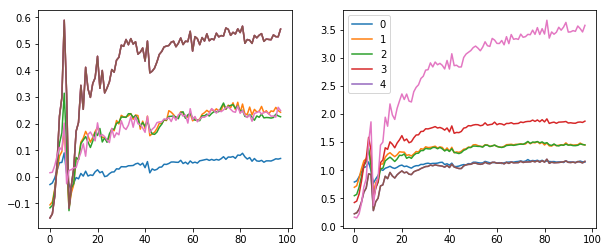
fig,axes = plt.subplots(2,2, figsize=(15,6))
for ax,h in zip(axes.flatten(), hooks[:4]):
ax.imshow(get_hist(h), origin='lower')
ax.axis('off')
plt.tight_layout()
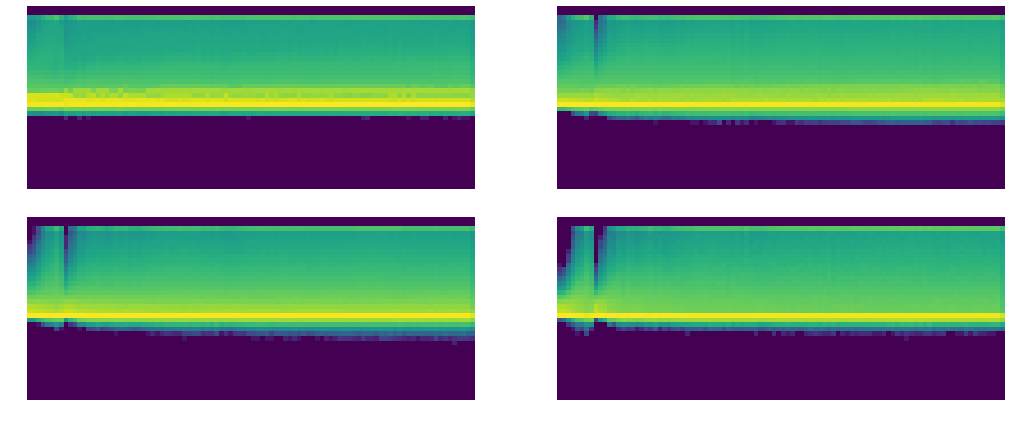
Most of values are in middle of Y axis
def get_min(h):
h1 = torch.stack(h.stats[2]).t().float()
return h1[19:22].sum(0)/h1.sum(0)
fig,axes = plt.subplots(2,2, figsize=(15,6))
for ax,h in zip(axes.flatten(), hooks[:4]):
ax.plot(get_min(h))
ax.set_ylim(0,1)
plt.tight_layout()
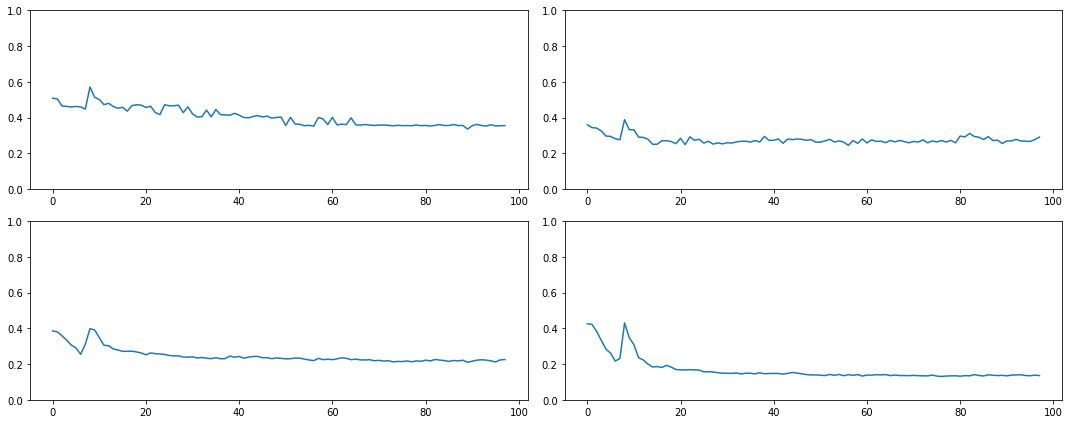
now many activations are empty close to 20-40 %
def get_learn_run(nfs, data, lr, layer, cbs=None, opt_func=None, uniform=False, **kwargs):
model = get_cnn_model(data, nfs, layer, **kwargs)
init_cnn(model, uniform=uniform)
return get_runner(model, data, lr=lr, cbs=cbs, opt_func=opt_func)
def combine_scheds(pcts, scheds):
assert sum(pcts) == 1.
pcts = tensor([0] + listify(pcts))
assert torch.all(pcts >= 0)
pcts = torch.cumsum(pcts, 0)
def _inner(pos):
idx = (pos >= pcts).nonzero().max()
actual_pos = (pos-pcts[idx]) / (pcts[idx+1]-pcts[idx])
return scheds[idx](actual_pos)
return _inner
def annealer(f):
def _inner(start, end): return partial(f, start, end)
return _inner
@annealer
def sched_cos(start, end, pos): return start + (1 + math.cos(math.pi*(1-pos))) * (end-start) / 2
class ParamScheduler(Callback):
_order=1
def __init__(self, pname, sched_funcs): self.pname,self.sched_funcs = pname,sched_funcs
def begin_fit(self):
if not isinstance(self.sched_funcs, (list,tuple)):
self.sched_funcs = [self.sched_funcs] * len(self.opt.param_groups)
def set_param(self):
assert len(self.opt.param_groups)==len(self.sched_funcs)
for pg,f in zip(self.opt.param_groups,self.sched_funcs):
pg[self.pname] = f(self.n_epochs/self.epochs)
def begin_batch(self):
if self.in_train: self.set_param()
sched = combine_scheds([0.5, 0.5], [sched_cos(0.2, 1.), sched_cos(1., 0.1)])
nfs = [8,16,32,32]
model = get_cnn_model(data, nfs, conv_layer, leak=0.1, sub=0.4, maxv=6.)
init_cnn(model)
opt = optim.SGD(model.parameters(), lr=0.9)
learn = Learner(model, opt, loss_func, data)
run = Runner(cb_funcs=cbfs+[partial(ParamScheduler,'lr', sched)])
run.fit(3, learn)
train: [0.915249296875, tensor(0.7182, device='cuda:0')]
valid: [0.2449265380859375, tensor(0.9281, device='cuda:0')]
train: [0.19559095703125, tensor(0.9404, device='cuda:0')]
valid: [0.11890172119140625, tensor(0.9652, device='cuda:0')]
train: [0.1000846484375, tensor(0.9703, device='cuda:0')]
valid: [0.09087188110351563, tensor(0.9732, device='cuda:0')]
run.fit(3, learn)
train: [0.087468759765625, tensor(0.9743, device='cuda:0')]
valid: [0.09696011962890624, tensor(0.9708, device='cuda:0')]
train: [nan, tensor(0.2529, device='cuda:0')]
valid: [nan, tensor(0.0991, device='cuda:0')]
train: [nan, tensor(0.0986, device='cuda:0')]
valid: [nan, tensor(0.0991, device='cuda:0')]
Thanks fast.ai for this tutorial.
Based on
https://github.com/fastai/fastai_docs/blob/master/dev_course/dl2/06_cuda_cnn_hooks_init.ipynb